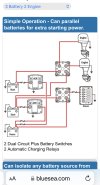Thank you all for sticking with this thread. And, in response to Skunk's last post, since I only have two batteries, it should make no difference, I would think, which switch is connected to which battery.
After my test run today, I have concluded that I likely have no problem of any significance. While nothing changed, since the output never dropped below 12.9 or so, and ultimately climbed back up to 13 plus or more, I am only going to throw one more part at this just because.
On Friday, I will be replacing the original Sea Star battery switch labeled starboard which is now, 13 years old. I replaced the other one last year since it was failing. It may not help but it can't hurt.
I also concluded today that in addition to my trim tilt being a major draw, the SeaStar automatic steering pump is also a major draw on battery number 1 no mater which position the battery switches are in. What I do not understand for the life of me is that I know that pump is wired directly to batter number 2, not number 1.
Somehow, somewhere, there is a crossover between the batteries. My guess is that it is through the battery switches since I know, given the right position, they can connect both batteries together.
Once again, I know this is tedious so thanks for the help.



